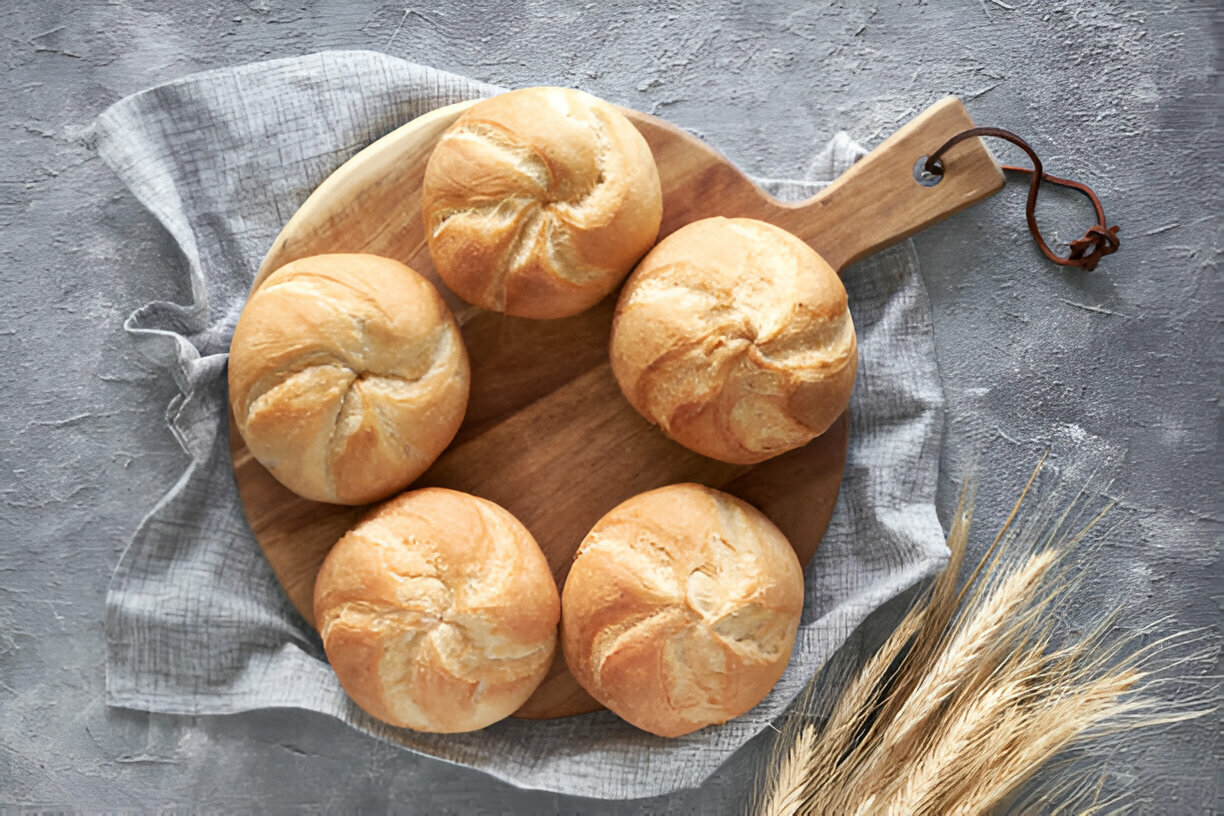
Kaiser Rolls Recipe
Bring the charm of a bakery into your kitchen with these soft, golden Kaiser rolls—perfectly crusty on the outside and tender on the inside. They're a beautiful and delicious way to level up your everyday meals.
Pin
Print
Save
Servings: 6 rolls
Calories: 260kcal
Ingredients
DOUGH
- 360 grams water at 90°F
- 30 grams olive oil
- 600 grams all-purpose flour plus extra for dusting
- 15 grams Diamond Crystal kosher salt
- 10 grams granulated sugar
- 6 grams instant yeast
TOPPINGS
- 1 –2 teaspoons milk
- 1 –2 teaspoons dried minced onion or substitute with sesame seeds, poppy seeds, or everything bagel seasoning
Instructions
- In the bowl of a stand mixer fitted with the dough hook, combine the flour, salt, sugar, and yeast. Whisk together briefly to evenly distribute the dry ingredients. Create a well in the center and pour in the warm water and olive oil. Begin mixing on low speed until a shaggy dough forms and clings together on the dough hook. This might take several minutes—scrape the sides of the bowl as needed to incorporate all the flour.
- Continue kneading the dough on low speed for about 5 minutes. The texture should start to smooth out while remaining slightly sticky to the touch. Pause to scrape the dough off the hook, flip it over, and knead for another 3–5 minutes until the dough becomes more elastic and supple, though still a bit tacky.
- Shape the dough into a rough ball and transfer it to a lightly greased bowl—reusing the mixer bowl is fine. If the dough clings to your hands, a touch of oil will make handling easier. Cover the bowl with a clean towel or plastic wrap and let it rise at room temperature until it doubles in size, about 1 to 1½ hours.
- Once risen, gently press down the dough to release excess air and turn it onto a clean, lightly floured surface. Divide the dough evenly into 6 pieces.
- Roll each piece into a rope about 20 inches long. Don’t taper the ends—keep the rope even in thickness. Lightly dust your hands with flour to prevent sticking, then form a loop in the middle of the rope by crossing the ends over each other. Thread one end through the center of the loop, leaving a small opening. Take that same end and wrap it around once more, pulling it back through the middle. Finally, bring the opposite end around the front and push it through the center, tucking both ends underneath the roll.
- Alternative Shape: If you prefer to stamp or score your rolls rather than knot them, shape each dough piece into a firm, round ball with the seam tucked underneath. These should be scored or stamped just before baking, after adding toppings.
- Arrange the shaped rolls on a parchment-lined baking sheet. Lightly spray the tops with non-stick spray, then cover with plastic wrap. Place another sheet pan directly on top to apply gentle pressure—this helps the rolls spread outward instead of rising too tall. Let the rolls rise again until very puffy and doubled in size, about 1 to 1½ hours.
- As the second rise nears completion, begin preheating your oven to 400°F to ensure it's ready when the dough is fully proofed.
- Right before baking, brush the tops of each roll with milk to encourage browning. Sprinkle with dried minced onion or your preferred topping. For round rolls, score 5 to 6 curved lines radiating from the center using a sharp knife or lame. If using a Kaiser stamp, press it firmly into each roll at this stage.
- Bake the rolls for 18 to 20 minutes, or until they turn a light golden brown. Once baked, remove from the oven and allow them to cool on the baking tray for 5 minutes before transferring to a wire rack to cool completely.
Notes
- If the round rolls rise into domed tops in the oven, gently place a sheet pan on top of them right after baking to flatten them slightly for a more burger bun-like shape.
- Do not apply pressure—the weight of the sheet pan alone will do the job.
- When using a Kaiser roll stamp, brush the rolls with milk first, then stamp the tops, and finally sprinkle with the onion topping.
- If the stamp sticks or doesn’t release cleanly, spray it with non-stick spray before each use.
- For a darker, crisper crust, extend the bake time by an additional 3–5 minutes.
Nutrition
Calories: 260kcal
Did you make this recipe?Want more delicious recipes like this? Follow us on Pinterest for daily inspiration! Click here to Follow me on Pinterest @feaztcom